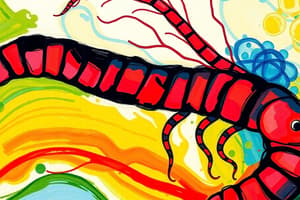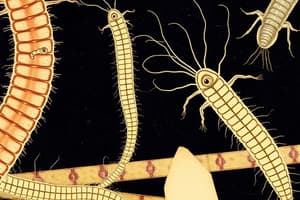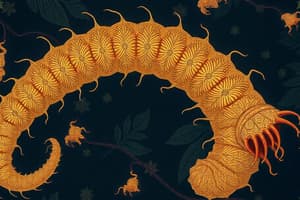Podcast
Questions and Answers
Which of the following statements is true regarding Ascaris lumbricoides?
Which of the following statements is true regarding Ascaris lumbricoides?
- The tail is often straight in males
- Males are larger than females
- Fertilization occurs in the uterus (correct)
- It has a monogenetic life cycle
The cuticle of Ascaris lumbricoides is composed of keratin.
The cuticle of Ascaris lumbricoides is composed of keratin.
False (B)
What is the infective stage of Ascaris lumbricoides?
What is the infective stage of Ascaris lumbricoides?
embryonated eggs with rhabditiform larva
The mode of transmission for Ascaris lumbricoides is through contaminated ______.
The mode of transmission for Ascaris lumbricoides is through contaminated ______.
Match the following characteristics with their corresponding terms related to Ascaris lumbricoides:
Match the following characteristics with their corresponding terms related to Ascaris lumbricoides:
What is the main characteristic that distinguishes nematodes from other worm groups?
What is the main characteristic that distinguishes nematodes from other worm groups?
All nematodes are parasitic.
All nematodes are parasitic.
What type of body organization do nematodes exhibit?
What type of body organization do nematodes exhibit?
Nematodes are also known as ________ due to their cylindrical shape.
Nematodes are also known as ________ due to their cylindrical shape.
Match the following nematode characteristics with their descriptions:
Match the following nematode characteristics with their descriptions:
Which of the following best describes the respiratory process in parasitic nematodes?
Which of the following best describes the respiratory process in parasitic nematodes?
Nematodes possess well-developed sense organs.
Nematodes possess well-developed sense organs.
What type of fertilization do nematodes undergo?
What type of fertilization do nematodes undergo?
Flashcards
Phylum Nemathelminthes (Nematoda)
Phylum Nemathelminthes (Nematoda)
A phylum of unsegmented, triploblastic worms with a pseudocoelom. They are cylindrical or thread-like and covered by a cuticle.
Pseudocoelom
Pseudocoelom
A fluid-filled body cavity not lined by mesoderm, found in nematodes.
Cuticle
Cuticle
The outer layer of a nematode, providing protection and structure.
Unisexual
Unisexual
Signup and view all the flashcards
Sexual dimorphism
Sexual dimorphism
Signup and view all the flashcards
Internal fertilization
Internal fertilization
Signup and view all the flashcards
Rhabditiform larvae
Rhabditiform larvae
Signup and view all the flashcards
Filariform larvae
Filariform larvae
Signup and view all the flashcards
Unisexual Phylum
Unisexual Phylum
Signup and view all the flashcards
Resistant Cuticle
Resistant Cuticle
Signup and view all the flashcards
Moulting in Ascaris Life Cycle
Moulting in Ascaris Life Cycle
Signup and view all the flashcards
Second Stage Larva
Second Stage Larva
Signup and view all the flashcards
Fertilization in Ascaris
Fertilization in Ascaris
Signup and view all the flashcards
Study Notes
General Zoology - Phylum Nemathelminthes (Nematodes)
- Nematodes are thread-like, unsegmented, triploblastic worms.
- They are pseudocoelomate, meaning their body cavity is not lined with mesoderm.
- Many are parasitic, while others are free-living.
- They have a cylindrical body that tapers at both ends.
- They have a complete digestive system with a mouth and anus.
- Their body is covered by a tough, resistant cuticle.
- They are often called roundworms.
- Their nervous system is relatively simple, with sensory organs like amphids and phasmids.
- They are unisexual with separate sexes, though males are usually smaller than females.
- Some exhibit sexual dimorphism.
Distinguishing Features: Free-living vs. Parasitic Nematodes
- Free-living nematodes typically have simpler excretory systems (or none at all) and are often found in soil or water.
- Parasitic nematodes have more complex excretory systems and often specialized structures for penetrating host tissues.
- Free-living nematodes are typically simpler in structure than parasitic nematodes, which often have adaptations for surviving within a host.
Mode of Transmission of Parasitic Nematodes
- Information on specific nematodes and their modes of transmission is included in the provided examples.
- Some parasitic nematodes may be transmitted via contaminated food or water or directly transmitted through contact.
- The specific transmission methods vary considerably across species.
Examples of Parasitic Nematodes and Diseases
- Ascaris lumbricoides: Roundworm causing ascariasis.
- Wuchereria bancrofti: Filarial worm causing elephantiasis.
- Enterobius vermicularis: Pin/threadworm causing churna.
- Loa loa: Eyeworm causing conjunctivitis.
- Ancylostoma duodenale: Hookworm causing ancylostomiasis.
- Trichuris trichiura: Whipworm.
- The provided document includes images of these specific nematodes.
Studying That Suits You
Use AI to generate personalized quizzes and flashcards to suit your learning preferences.




